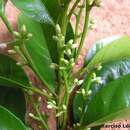en
names in breadcrumbs


The "Pogonophora", or beard worms, live in thin tubes buried in sediments at ocean depths from 100 to 10,000 meters. The tubes are composed of chitin and scleroproteins secreted by the epidermis. Most pogonophorans are less than 1 mm in diameter, but 10 to 75 cm in length. The tubes may be 3 to 4 times the length of the worm. Beard worms have a complex closed circulatory system and a well developed nervous system (with a ventral nerve cord, as in other protostomes), but no digestive tract in adults. The mode of nutrition remains unclear, although most beard worms seem to be able to absorb dissolved organic material from their environment and symbiotic bacteria appear to be involved. Beard worms have separate males and females. Fertilization has not been observed, but males apparently release sperm packaged into spermatophores, which then drift to the open tubes of nearby females. Developing embryos have been found within tubes. Larvae are ciliated and motile, remaining at the surface for a short time (until around 8 days old in lab observations) before swimming down through the water colum to settle and secrete their tubes. (Young et al. 1996; Brusca and Brusca 2003) The morphology of vestimeniferan larvae was described by Gardiner and Jones (1994).
The "Pogonophora", as defined based on numerous analyses, now includes the "Vestimentifera", a group formerly treated as a distinct phylum based on a number of morphological differences (Rousset et al. 2004 and references therein; Pleijel et al. 2009). The phylogenetic position of pogonophorans has itself been much debated since they were first discovered in the early 1900s, but they appear now to to be nested clearly within the phylum Annelida, with the former phyla "Pogonophora" and "Vestimentifera" now being treated together as the family Siboglinidae (Struck et al. 2007 and references therein; Pleijel et al. 2009 and references therein).
Pogonophora is a plant genus of the family Peraceae first described as a genus in 1854.[2][3] It is native to central Africa and northern South America.[1][4]
moved to other genera (Micrandra, Pausandra)
Pogonophora is a plant genus of the family Peraceae first described as a genus in 1854. It is native to central Africa and northern South America.
Species Pogonophora letouzeyi Feuillet, 1993 - Gabon, Congo Pogonophora schomburgkiana Miers ex Benth., 1854 - Colombia, Venezuela, Guyana, Suriname, Fr Guinea, N + E Brazil formerly includedmoved to other genera (Micrandra, Pausandra)
P. cunuri - Micrandra spruceana P. trianae - Pausandra trianae